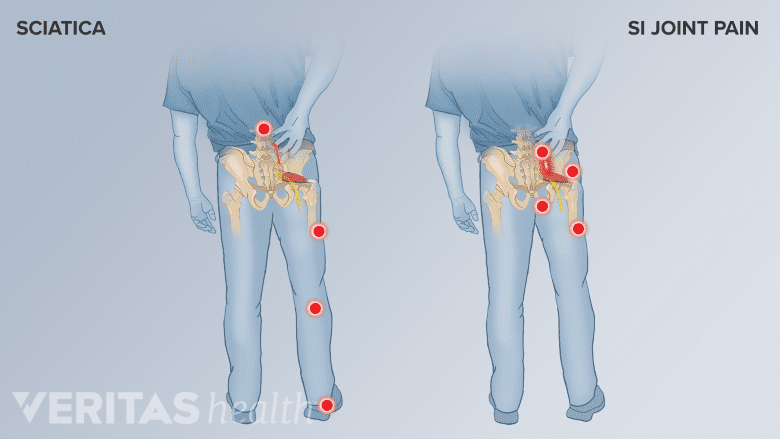The main symptoms of sacroiliitis include a dull ache in the buttocks, lower back, and hip., In contrast, the main sciatica symptoms include sharp, shooting, or burning lower back pain, leg pain, and numbness or weakness in the affected leg.
The underlying causes of sacroiliitis and sciatica are different

Sacroiliitis and sciatica pain may occur in the lower back, buttock, hip and/or leg.
Both sacroiliitis and sciatica can cause symptoms in your buttocks, hip, and/or leg, but their underlying causes differ.
Sacroiliitis is a medical condition that causes inflammation in the sacroiliac joints, which connect the sacrum bone at the base of the spine to the hip bones. The inflammation can cause pain in the lower back, buttocks, and legs.
Ankylosing spondylitis, a type of inflammatory arthritis, is the most common cause of sacroiliitis. Other causes may include acute or chronic trauma and infection of the SI joint.
Watch Video: What is Sacroiliitis?
Sciatica is a set of symptoms that occurs when the sciatic nerve is irritated or compressed. The sciatic nerve is the largest in the body, spanning from the lower back to the feet. When the nerve gets compressed as it exits the lower spine, it can cause pain, numbness, and weakness in the areas it supplies, including the lower back, buttocks, and legs.
A lumbar herniated disc is the most common cause of sciatica. Other causes include spinal stenosis, degenerative disc disease, and spondylolisthesis.
Read more about Sciatica Causes
Identifying the problem based on your symptoms

SI joint pain and sciatica symptoms can feel similar.
Several symptoms of sacroiliitis and sciatica overlap, and you may be confused about the actual source of your back and leg pain.
Here are a few unique pointers to help you understand where your pain may be originating from:
- Areas affected by pain:
- In sacroiliitis, lower back, buttock, and hip pain is typically more common than leg pain.
- In sciatica, leg pain is usually greater than lower back pain, and the pain may radiate into your toes. The affected leg may also feel heavy.
- Intensity of pain:
- In sacroiliitis, the pain is usually a dull ache that increases when sitting for long periods and/or during activities that involve bending or twisting the hip.
- In sciatica, the pain is usually described as sharp, shooting, or burning.
- Altered sensation:
- Sacroiliitis can cause stiffness and swelling in the lower back and buttock region.
- Sciatica often results in numbness, tingling, or weakness in the affected leg.,
While these are relatively common pain patterns, some people may experience other symptoms specific to the underlying cause of their pain.
Treatment options vary for sacroiliitis and sciatica
Successful low back pain treatment depends on addressing the underlying cause of inflammation or irritation to the joints, nerves, and other tissues in the lower back.
- Sacroiliitis treatment focuses on reducing pain and inflammation, improving joint function, and preventing further damage to the SI joint.
- Sciatica treatments can vary and primarily focus on managing the underlying cause of sciatic nerve root compression.
A physician trained in treating musculoskeletal conditions can accurately diagnose the underlying cause of your pain and formulate an effective treatment plan.

